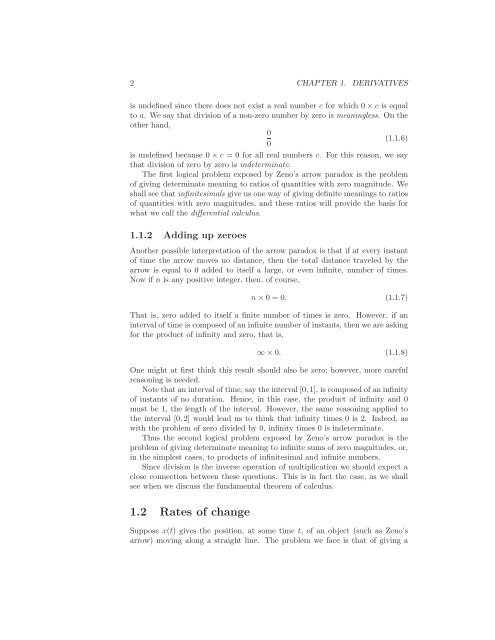Yet Another Calculus Text, 2007a
Yet Another Calculus Text, 2007a
Yet Another Calculus Text, 2007a
Create successful ePaper yourself
Turn your PDF publications into a flip-book with our unique Google optimized e-Paper software.
2 CHAPTER 1. DERIVATIVES<br />
is undefined since there does not exist a real number c for which 0 × c is equal<br />
to a. We say that division of a non-zero number by zero is meaningless. Onthe<br />
other hand,<br />
0<br />
(1.1.6)<br />
0<br />
is undefined because 0 × c = 0 for all real numbers c. For this reason, we say<br />
that division of zero by zero is indeterminate.<br />
The first logical problem exposed by Zeno’s arrow paradox is the problem<br />
of giving determinate meaning to ratios of quantities with zero magnitude. We<br />
shall see that infinitesimals give us one way of giving definite meanings to ratios<br />
of quantities with zero magnitudes, and these ratios will provide the basis for<br />
what we call the differential calculus.<br />
1.1.2 Adding up zeroes<br />
<strong>Another</strong> possible interpretation of the arrow paradox is that if at every instant<br />
of time the arrow moves no distance, then the total distance traveled by the<br />
arrow is equal to 0 added to itself a large, or even infinite, number of times.<br />
Now if n is any positive integer, then, of course,<br />
n × 0=0. (1.1.7)<br />
That is, zero added to itself a finite number of times is zero. However, if an<br />
interval of time is composed of an infinite number of instants, then we are asking<br />
for the product of infinity and zero, that is,<br />
∞×0. (1.1.8)<br />
One might at first think this result should also be zero; however, more careful<br />
reasoning is needed.<br />
Note that an interval of time, say the interval [0, 1], is composed of an infinity<br />
of instants of no duration. Hence, in this case, the product of infinity and 0<br />
must be 1, the length of the interval. However, the same reasoning applied to<br />
the interval [0, 2] would lead us to think that infinity times 0 is 2. Indeed, as<br />
with the problem of zero divided by 0, infinity times 0 is indeterminate.<br />
Thus the second logical problem exposed by Zeno’s arrow paradox is the<br />
problem of giving determinate meaning to infinite sums of zero magnitudes, or,<br />
in the simplest cases, to products of infinitesimal and infinite numbers.<br />
Since division is the inverse operation of multiplication we should expect a<br />
close connection between these questions. This is in fact the case, as we shall<br />
see when we discuss the fundamental theorem of calculus.<br />
1.2 Rates of change<br />
Suppose x(t) gives the position, at some time t, ofanobject(suchasZeno’s<br />
arrow) moving along a straight line. The problem we face is that of giving a


















